Lesson plan template – Best downloads and advice for UK teachers
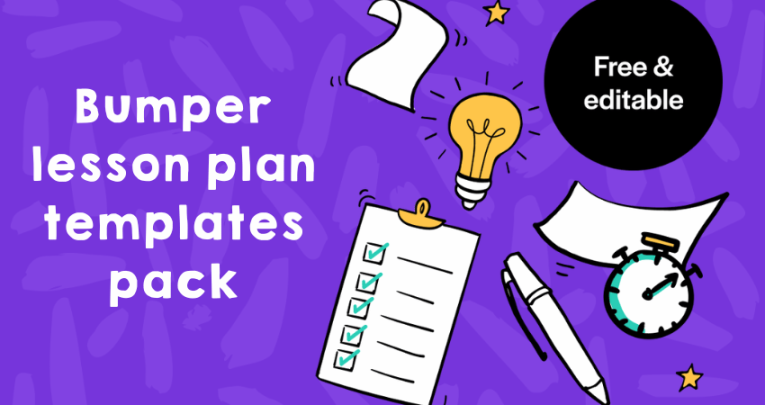
Save time preparing your lessons with this collection of printable templates for all age groups…

- by Teachwire
- Classroom expertise and free resources for teachers

Looking for a lesson plan template that you can download, edit and print out? We’ve got you covered!
JUMP TO A SECTION
- Bumper lesson plan templates pack
- Lesson planning mantras
- More blank lesson plan templates
- How to use sequence learning to save yourself time
- Are scripted lessons creating zombie teachers?
- Use these 5 ‘cogs’ to plan lessons like a pro
- Why you should stop planning lessons
- How to end lessons successfully
- Why originality is overrated when it comes to lesson planning
Bumper lesson plan templates pack
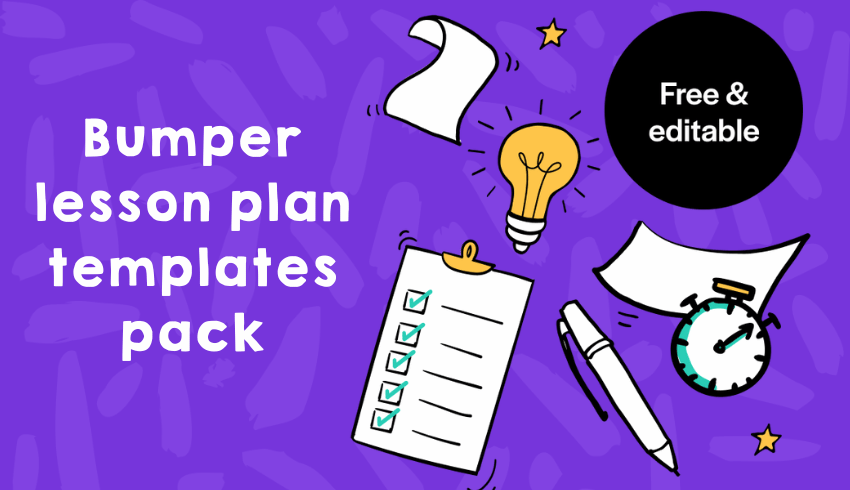
Short on time and want to browse 11 of the lesson plan templates listed below? Download our free bumper lesson plan templates pack with one click.
Lesson planning mantras
Before you browse the below templates and start planning like a pro, have a quick glance at these lesson planning mantras from deputy headteacher Matt Lewis…
- You have a year to teach your class – too much information at the start of a unit of work can overwhelm pupils. A slow start to a series of lessons is fine.
- Start with your learning objectives and make sure they have context. This will help you with the rest of your plan.
- Do your lessons incorporate a magical moment that children will remember and discuss at home? Not every lesson can be mind blowing, but the more ‘wows’ you can create, the more outstanding your lessons will be.
- If you’re finding planning sessions difficult, step away from your laptop and go back to basics. Doodle your ideas down on paper and go from there.
- Give yourself room to plan by setting aside a substantial chunk of time for it in your schedule.
- Take ownership – these are your plans and you should be proud of them.
- Not all lessons will go perfectly, and some will be outright disasters. Jot down your thoughts on your written plans so next year you can redraft them.
- There’s no set-in-stone lesson structure. The more you play with the order, the more interesting your lessons will be.
- Always, always aim to connect with your class. How will this lesson capture pupils’ imaginations? They’re constantly bombarded with computer screens and digital imagery, so what is going to make this lesson stand out?
Blank lesson plan template with support sheet
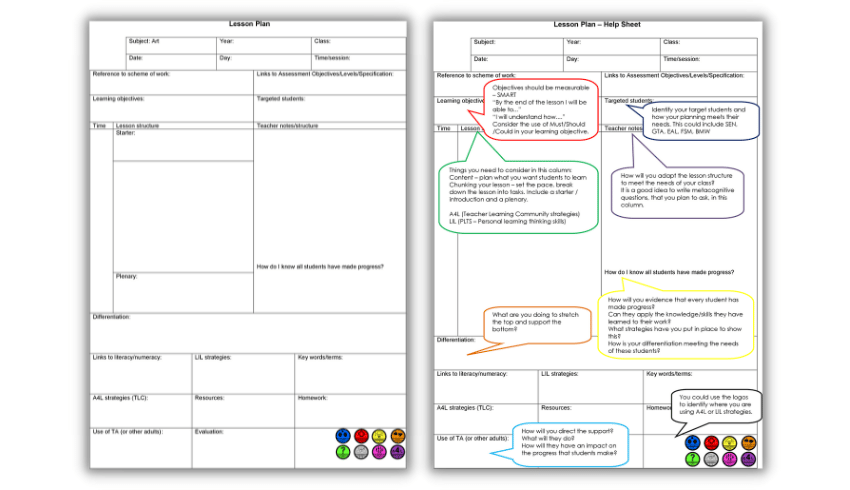
This download contains two editable Word documents – a blank lesson plan template and a support sheet to help you fill it out. This resource is particularly great for early career teachers.
There is space on the template for noting:
- Reference to scheme of work
- Link to assessment objectives/levels/specification
- Learning objectives (these should be specific, measurable, achievable, relevant and time-bound)
- Targeted students (this could include SEN, EAL, FSM)
- Lesson structure (including starter and plenary ideas)
- Differentiation (what you’re doing to stretch the top and support the bottom)
- Links to literacy/numeracy
- Leading in learning stategies
- Key words/terms
- Assessment for learning strategies
- Resources
- Homework
- Use of TA
- Evaluation
Things to consider:
- What do you want students to learn?
- How will you split your lesson into chunks?
- Can you adapt the lesson structure to meet the needs of your class?
- How will you know if all students have made progress?
- How will you direct TAs? What will they do and how will they have an impact?
Editable primary lesson plan template and English unit planning grid
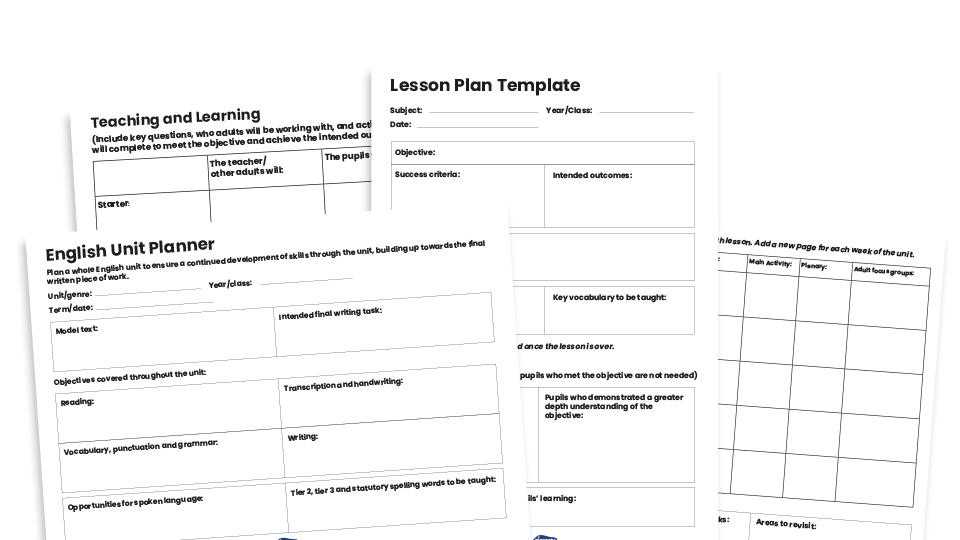
This pack from Plazoom includes a lesson plan template (in PDF and editable formats) that can help early career teachers and supply teachers to structure their lessons.
It’s also helpful for planning and developing ideas if your lesson is going to be observed.
The plan follows a simple format which is easy to complete and then follow throughout the delivery of your lesson. The opportunity to assess pupils’ understanding against the objective and identify next steps in learning will help you to plan subsequent lessons for classes and groups of pupils.
Also included is a template that will support you to plan and deliver a whole English unit for writing. There is space at the start for you to identify the model text/s used and the intended final piece of writing that the pupils will complete, to aid you when planning the steps needed to build up to the eventual writing outcome.
You can reproduce the weekly planning grid according to the number of teaching weeks in your unit.
Editable lesson plan template
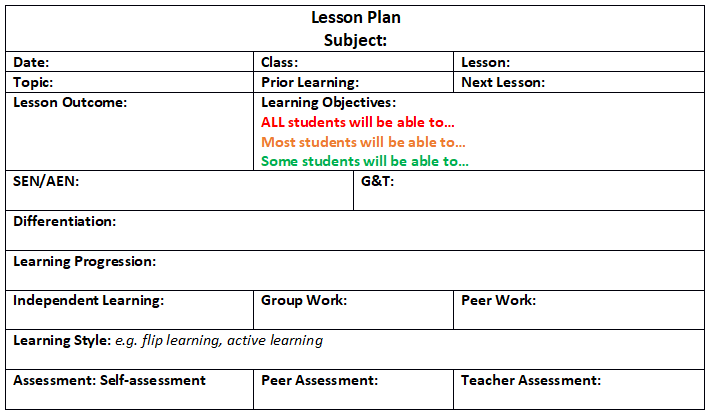
This editable Word document lesson plan template allows you to add or delete rows as required. It includes the following fields as a starting point:
- Topic
- Prior learning
- Next lesson
- Lesson outcome and learning objectives
- SEN/AEN
- Gifted & talented
- Differentiation
- Learning progression
- Independent learning/group work/peer work
- Learning style (eg flipped learning, active learning)
- Assessment (self, peer, teacher)
- Literacy, numeracy and ICT links
- Starter, plenary and extension
- Stretch questions
- Activities
- Health and safety
- Technician/teaching assistant
- Homework
Lesson plan template for EYFS
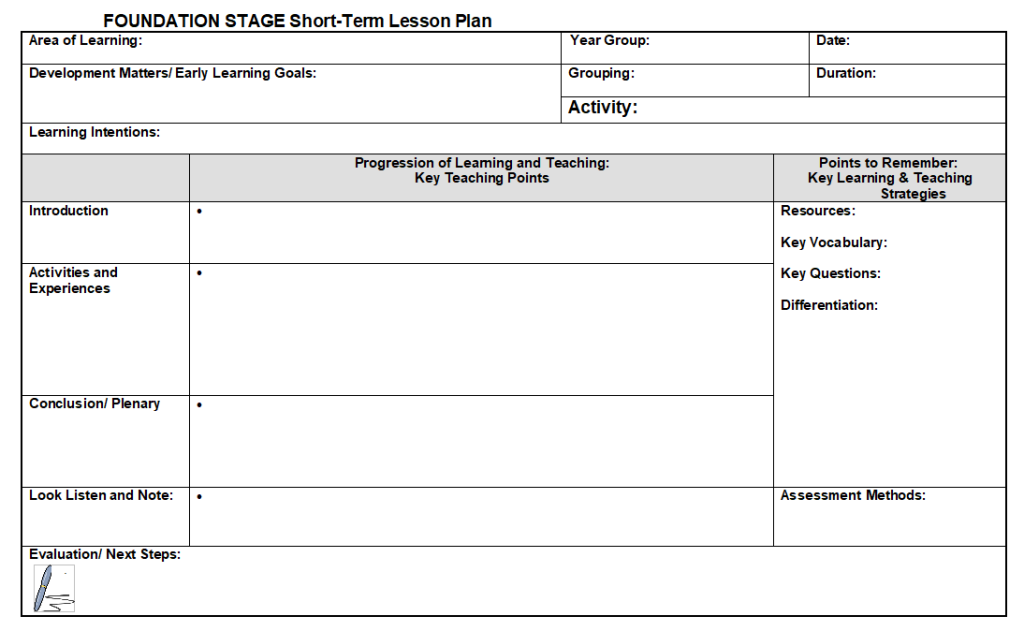
This blank Word document lesson plan is perfect for Early Years and can easily be adapted to suit your needs.
There’s space to note Early Learning Goals, key teaching points (including introduction, activities and plenary) and key learning and teaching strategies.
You can also note your assessment method and next steps.
Adaptable lesson plan template for KS1 and KS2
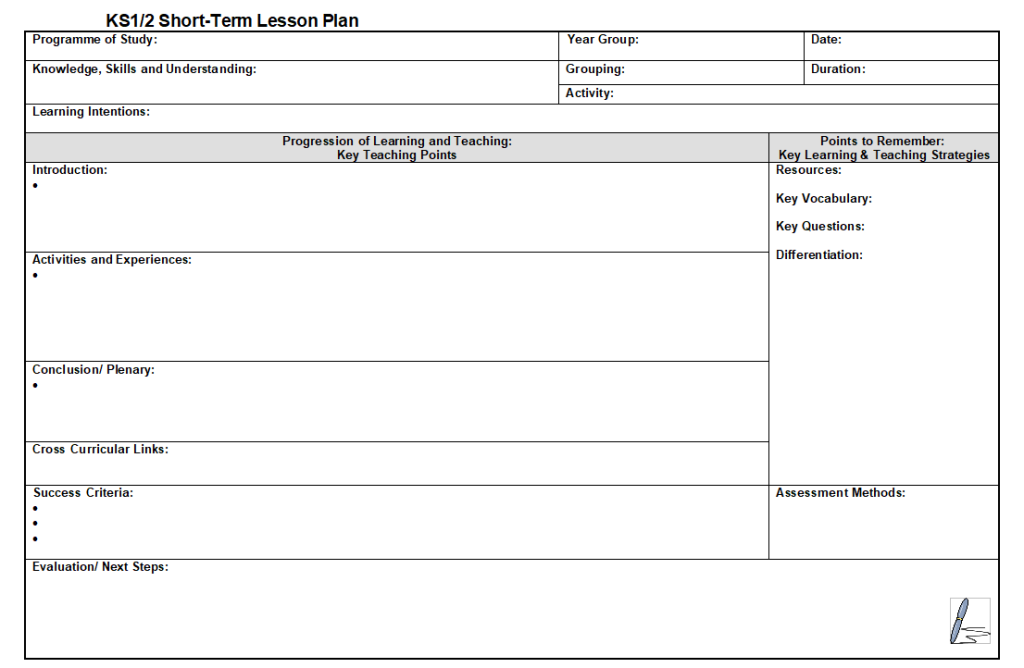
This is a straightforward, easy-to-adapt Word document blank lesson plan for KS1/2. Use it to note down the following:
- Knowledge, skills and understanding
- Learning intentions
- Key teaching points (including intro, activities and plenary)
- Cross-curricular links
- Success criteria
- Key learning and teaching strategies (vocabulary, questions, differentiation)
- Assessment methods
- Next steps
Observed lesson plan template
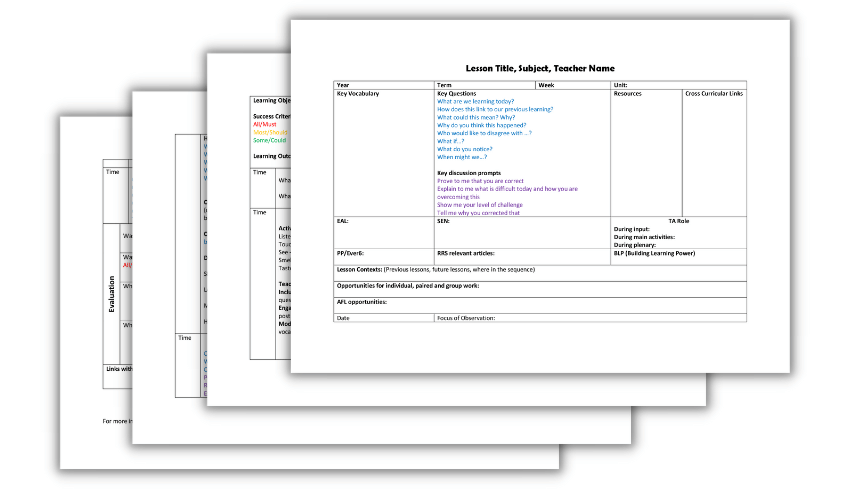
This is a useful editable Word document lesson plan template to help you remember everything you need when planning for an observation. It’s particularly suitable for primary but is easy to adapt for secondary.
The download contains a four-page editable Word document that includes helpful tips and higher-level thinking questions to help you structure the lesson and ensure that everyone makes progress.
The guidance contains:
- Key questions to think about
- Key discussion prompts
- Ideas for including all children, engaging and inspiring and modelling learning
- Higher level thinking questions
- Ideas for differentiation
- Ideas for challenges and plenaries
Backwards lesson planning template
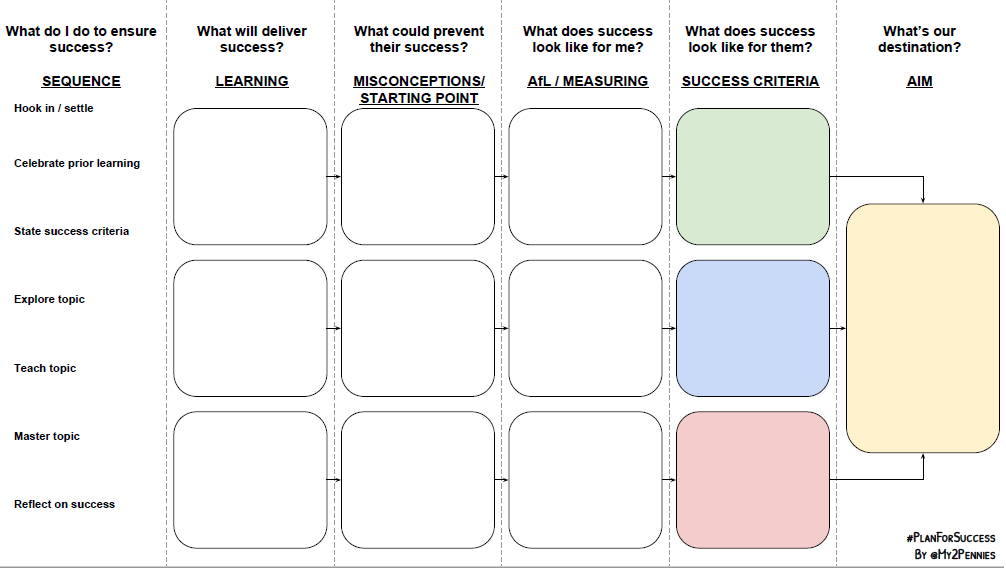
We always start a journey by identifying the destination first and then planning the best route. Why should planning for learning be any different? This PDF template helps with backward planning of lessons.
Start from the right-hand column – going backwards. Omit the left-hand column if you are using this template to plan a sequence of lessons or a unit of work.
Very simple blank lesson plan template
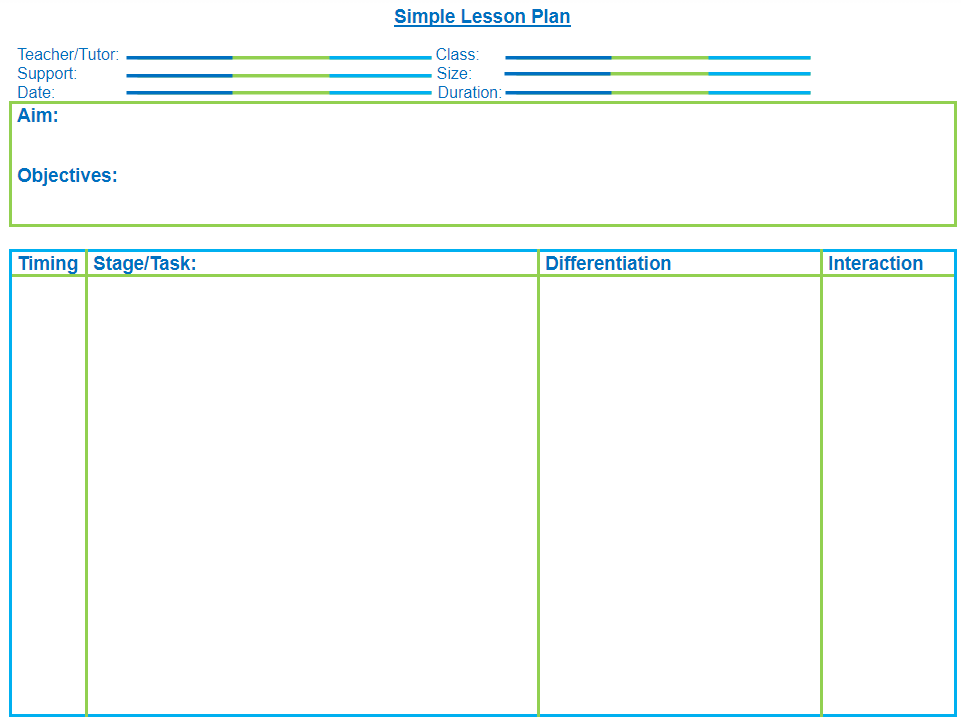
Lesson plan templates don’t get much more simple than this. This editable Word document features space for your lesson’s aims and objectives.
Note down the different stages of your lesson, how you will differentiate and how you plan to interact with pupils.
Editable blank lesson plan template with instructions
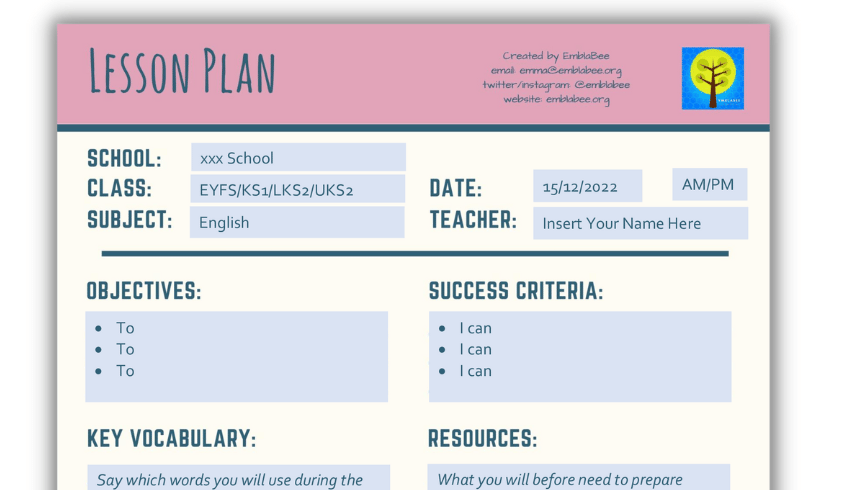
This is a simple lesson plan for teachers, student teachers and supply teachers to use when planning lessons.
There is a PDF version, suitable for making speedy handwritten notes, that can you think through what you’re doing and pass on the information necessary for your sessions to TAs and classroom support.
Also supplied is an editable Word doc version, with notes on how to fill in the text boxes. It’s a clear and easy-to-follow record of intentions for a lesson.
There’s space on this template to jot down:
- Objectives
- Success criteria
- Key vocabulary
- Resources (what will need to be prepared before the lesson)
- Introduction (how you’ll engage the children and introduce the activities)
- Main activity (use this space to explain how you will differentiate, use TA support etc)
- Plenary (how you will wrap things up)
5-minute lesson plan and evaluation templates
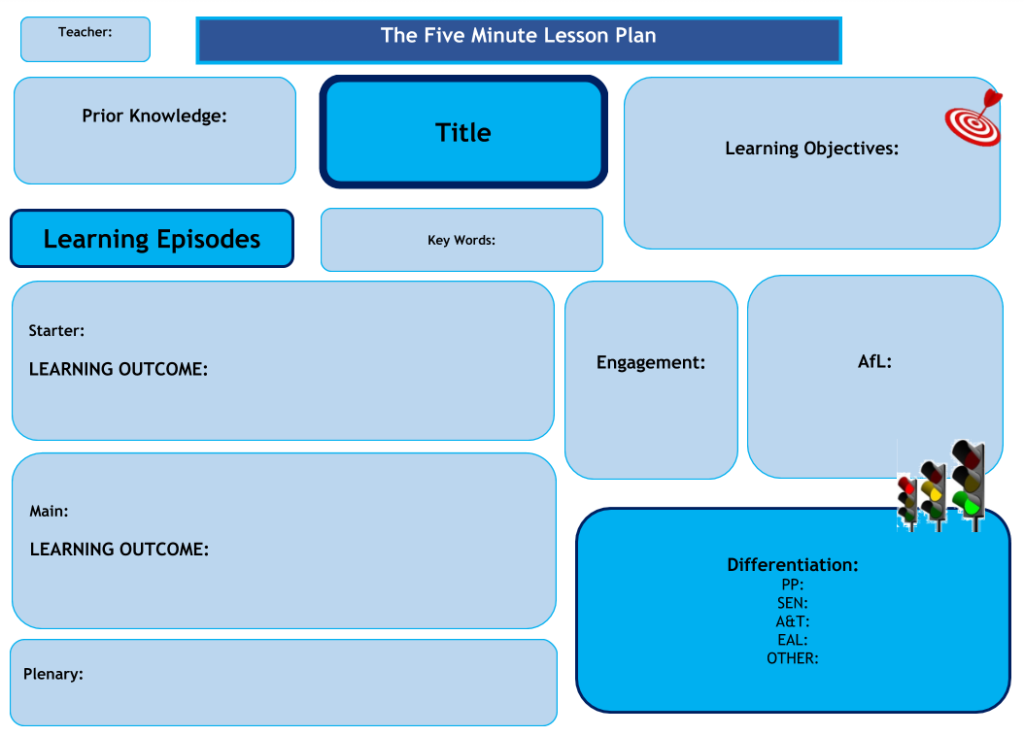
These easy-to-use Word document lesson plan and lesson evaluation templates are simple to edit and fill out.
The lesson plan contains space for:
- Prior knowledge
- Key words
- Learning objectives
- Starter, main and plenary activities
- Engagment
- Assessment for learning
- Differentiation
The lesson evaluation template allows you to reflect on your feelings after the lesson (positive and negative). There’s space to evalaute:
- Planning
- Pupil engagement
- Teaching and communication
- Behaviour management
- Resources
- Impact on learning
Finish by adding targets for the next lesson.
Comprehensive lesson plan template
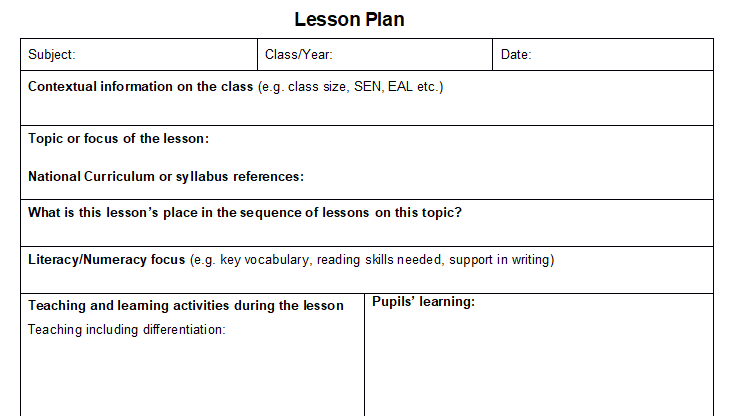
Whether you’re a PGCE student, an ECT or a seasoned teacher being observed, you’ll find this comprehensive lesson plan template useful.
It’s an editable Word document, meaning you can adjust it to suit your needs. It contains space for the following:
- Contextual information on the class (eg class size, SEN, EAL)
- Focus of lesson
- Curriculum links
- Literacy/numeracy focus (eg key vocabulary)
- Activities (including differentiation plans)
- Homework
- Resources
- TA’s role
- Assessment for learning
- Targets from previous observations
- Your evaluation of the lesson
Lesson plan template PowerPoint
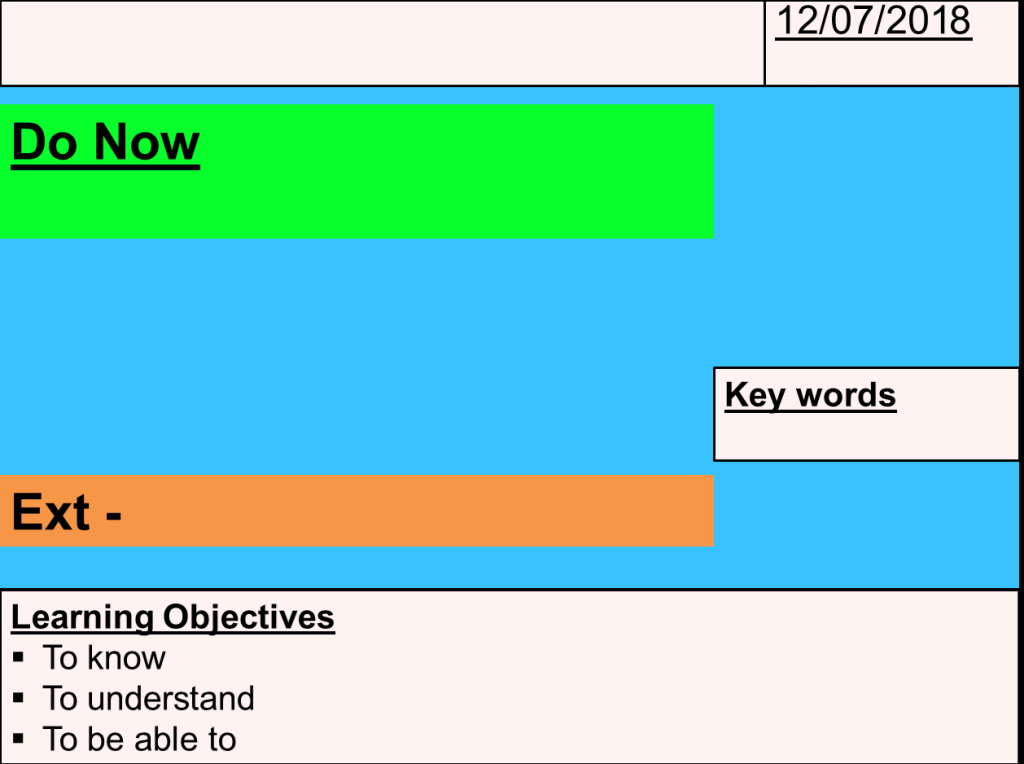
This PowerPoint lesson plan template is designed for you to show on your smart board to pupils at the start of your lesson.
The first slide includes an auto-complete date (so there’s no need to change the date every time you give the lesson) as well as space for keywords, learning objectives and a starter (including extension activities).
There are three blank slides which you can use to add in tasks, then finish by showing the ‘What have we learnt?’ and homework slides.
The background is blue with a simple font to support students with dyslexia.
How to use sequence learning to save yourself time

Forget flashy lessons – simple can be beautiful, and can give you your life back, says primary deputy head Aidan Severs…
Imagine a way of working that was not only more responsive to children’s needs, but was also better for teacher wellbeing. If there was such a way, surely we’d all want to be doing it?
I’d like to suggest it is possible. By planning learning sequences and designing lessons flexibly we can provide for individual needs without it being a huge burden on our time and energy.
All-singing, all-dancing
In order to ensure that our planning and teaching doesn’t impact negatively on our wellbeing, we have to find an efficient way to work. And in order for something to be efficient, it usually needs to be simple.
However, teaching can often be overcomplicated by myriad solutions for how to engage children, manage behaviour, include technology, make links to other subjects, and so on.
Often we begin lessons with an activity idea that we’ve seen on social media or used elsewhere in the past. Sometimes we come with preconceived ideas about what makes an outstanding lesson and we pull out all the stops and try to plan all-singing, all-dancing sessions.
“We pull out all the stops and try to plan all-singing, all-dancing sessions”
Other times, often due to time pressures, we just don’t think carefully enough about what children need. All of these approaches can lead to a lesson being insufficiently structured to support learning.
The true way to simplify teaching begins at the planning stage. There are several things to think about when you’re sitting in your PPA session. Begin by asking yourself a simple set of questions. Here’s the first:
What do the children need to learn?
You’ll probably come up with several answers, because different children will need to learn different things.
This is where workload can begin to triple or quadruple: as soon as you identify the fact that one handful of children need to go over previous work whereas others are ready to move on, it can be easy to start thinking that you need to plan several different tasks.
This is where planning teaching sequences comes into play.
Rather than planning five lessons, plan a sequence of activities that will help children to work through from not knowing how to do something to being fluent in it to being able to use and apply that knowledge or skill.
The next question to ask yourself will help you think about learning as steps towards a final goal:
How can I break this down and teach it in the simplest way possible?
If you produce a sequence of activities that build to an end point, you most probably have something relevant for each child in the class to attempt. This negates the need for differentiation and removes that potentially damaging way of providing for children that perpetuates the learning gap.
As you plan each step, take into account the answers to the following questions:
- How can pupils practise this in the simplest way possible?
- Is this aspect of the lesson really necessary for children to achieve the intended outcome?
Try to make each step and task as simple as possible, ensuring that the sole focus of the sequence is on exactly what the children need to learn. Your learning steps don’t need to be full of flashy activity ideas.
“Try to make each step and task as simple as possible”
Enjoyment and engagement of learning can, and should be, intrinsic. The act of learning is enjoyable and engaging, providing that you are actually learning.
A simple sequence almost guarantees that learning will take place and the children will feel good about it. They won’t miss the flashy teaching techniques you’ve used in the past. They’ll just be enjoying the feel-good factor that comes with mastering something new.
Flexible lessons
That’s the planning phase sorted, then. But trying to use the activities produced when planning a learning sequence can prove difficult.
One group of children could end up working on step one, another on step two while yet another moves on to step three. How do you keep a handle on this in the classroom?
Flexible lesson design is the answer here.
For example, if on day two of teaching your planned learning sequence you have several groups of children all working at different steps in the sequence you will need to work out how to use that hour in the classroom to the best effect for all.
Start working with one group while others begin the next task – clearly written or visual instructions will help with this. Once this is done, set a task for the group you were working with then check the work done by other groups.
Then, based on your assessment, give an input to another group while others continue with the initial task.
The ‘lesson’ (although no longer a lesson in the traditional, three-part sense) can continue this way until all children are working, at which point you can begin to give one-to-one feedback.
Reduce the burden
At any point a child might be ready to move on to the next step in the sequence. And they can, because the tasks have all already been prepared at the beginning of the week.
If you’ve also taken the time to provide answer sheets children can even self- or peer-mark to reduce the burden on you. This ensures that pupils aren’t waiting around for their work to be seen.
Planning a sequence of activities for all children to work through at their own pace means that you won’t be planning and preparing five days’ worth of three or more lots of differentiated tasks. It’ll just be around five tasks that you will support everyone to access, perhaps with an extra one on top to stretch children who need a challenge.
That’s a lot less work to plan and prepare.
By asking yourself the above questions as you plan, the activities you prepare within a sequence should be simple. This means that you can spend far less time decorating and laminating your resources.
“Simple can be beautiful, and it can give you your life back”
Teaching lessons flexibly should mean that you begin to use lesson time more effectively, particularly for giving feedback. In doing this, you remove the need for so much time to be spent on marking outside of lessons.
Any assessment information you do gather will simply inform you which task in the pre-planned sequence each child needs to work on next, rather than causing you to plan another new activity in response.
- Scenario
Your Y3 class needs to learn how to add common prefixes to words and use them in their work. Note that the national curriculum mentions four: ‘in’, ‘un’, ‘dis’ and ‘mis’. - Activity 1
Pupils will have covered ‘un’ in their spellings already so this makes a good starting point. First add the prefix to selected words (this will remind children that it changes the meaning of a word to its opposite and that the spelling of the root word remains intact). Next, add root words to the prefix. Finally, give a definition for a selection of words beginning with the prefix. These three tasks will give you an opportunity to assess what children remember of previous learning. Some will need more teaching on the prefix ‘un’ at this point, whereas others will be ready to move on. - Activities 2-3
Rather than mixing things up to make them more interesting, repeat the above sequence with the prefixes ‘dis’ and ‘mis’. One meaning of the ‘in’ prefix departs from the ‘not’ definition the pupils have found in the other prefixes, so leave this one for another learning sequence. - Activity 4
Contextualise the words pupils have learnt by choosing the correct prefix to complete a sentence and writing a sentence including one of the new words. The idea is to make each task as simple as possible so that the sole focus of the sequence is on exactly what the children need to learn.
Are scripted lessons creating zombie teachers?

Scripted lessons are being touted in certain circles as the solution for all of our education system’s ills but Kevin Rooney – teacher, author, and convenor of the Academy of Ideas Education Forum – is not so sure…
Have you heard of the late American educationalist Siegfried Engelmann? His big idea was ‘scripted teaching’.
The thinking behind it goes something like this: too often teachers are unclear and ambiguous in their instruction and explanations. Thus, due to poor teaching pupils take on misconceptions and don’t make as much progress as they should in the classroom.
Scripted teaching will solve this problem, advocates claim. Carefully planned lessons designed around small learning increments aim to improve progress by eliminating any potential for misinterpretation.
Centrally produced plans will be distributed to teachers, who will read out and deliver lessons from the scripts. The opportunity for educators to digress and make mistakes will be reduced.
Instead, standardised scripts will ensure consistency, structure and quality assurance.
Growing support
A growing number of schools have already adopted scripted teaching, particularly Multi Academy Trusts (MATs).
Other supporters include John Blake, head of social policy and education at Policy Exchange, and Mark Lehain, director of Parents and Teachers for Excellence.
They argue that a prescriptive approach is necessary to ensure pupils get the right progression in their learning.
Blake asserts that experts working outside the classroom to design lessons or materials for teachers to follow reduces bad teaching, and has the potential to provide every child with a consistently high standard education.
Proponents insist that the scripts can be precisely calibrated to ensure that knowledge is imparted efficiently and unambiguously.
At present the extent of script teaching is on a spectrum and is more suited to certain age groups and subjects than others. But with the emergence of academy chains it is on the rise.
These institutions generate their own resources centrally and then disseminate it to dozens of schools and hundreds of teachers to deliver as one.
In some schools standardised script teaching is optional; but in others, it is compulsory.
Consistent quality
Arguing in favour of this new approach at an Academy of Ideas Education Forum debate on the topic, educationalist Kris Boulton asked, “Can we really trust half a million separate teachers to write their own lesson plans?”
To which, for supporters of scripted teaching, the answer seems to be, “No”.
“Can we really trust half a million separate teachers to write their own lesson plans?”
He contrasted the hit and miss approach of half a million teachers doing their own thing to the advantage of a standardised script that delivers an instruction sequence that has been refined and rigorously field tested over multiple years, generated by research and experienced experts that individual teacher could never achieve.
Not to move towards standardised script teaching is akin to rolling the dice with our children’s future, he said.
The argument now being put forward by educationalists in favour of scripted teaching is that that schools have a moral duty to teach via standardised scripts developed centrally by experts.
John Blake argued in a 2018 Policy Exchange paper that the only way we can deliver on the promise of the 2014 National Curriculum is with the move to scripted teaching.
He thinks it unhealthy for teachers to believe they should only be delivering things that they have designed themselves.
He adds that scripts could reduce workload and liberate teachers from the exhausting drudgery of having to prepare individual lesson plans.
Mistrust and uniformity
So should we welcome or reject scripted teaching? I have to confess that the prospect of teaching to a standardised lesson plan fills me with horror.
So much so, indeed, that if compelled to do so I would leave the profession.
“For me, this approach represents the antithesis of everything I think it is to be a teacher”
The move to embrace scripts is driven by a mistrust of teachers. It rests on the assumption that we are not professional or qualified enough to design and teach our own lessons.
It will erode teacher autonomy and sow further insecurity in an already insecure profession.
We have to ask: what is our model of a teacher? With standardised teaching, it’s that of an automaton.
Relational activity
In contrast, I believe that when we enter the teaching profession we are being inducted into a community of scholars and of subject specialists.
In conveying the love and understanding of our subject to pupils we must be able to exercise judgement and discretion in exactly how we transmit knowledge and ideas.
Teaching is a relational activity in which we get to know our students as human beings. Quite often in lesson I go off piste on all sorts of tangents.
Sometimes these learning adventures will not help students pass a test, but so what? If I think it appropriate to nourish pupils’ intellectual curiosity, or answer all sorts of questions not related to the lesson plan, I will do so.
Scripted teaching discourages deviation or wider exploration. It tells us what to teach and how. It demands uniform compliance.
Liberation, or disaster?
The culture in schools today, encouraged by intense accountability measures, tends towards teaching to the test and improved exam results at all costs.
In this context a desperate search is on for the silver bullet that will consistently deliver those optimal final grades.
Many at the top of the educational tree see scripted teaching as the answer. But I contend that the rise of the scripted teacher is not a panacea.
Indeed, in the midst of a retention and recruitment crisis I fear it will lower the intellectual bar and accelerate deprofessionalisation.
The reification of scripted lessons redefines teaching from an art to a science.
Put in shackles
In essence we have arrived at a moment where the agency and humanity of the teacher in the classroom is being subordinated to the iron cage of rationality gone mad.
Those pushing scripted teaching argue it is about putting in structures to support young teachers. But where they see support, I see teachers being put in shackles, and the zombification of our profession.
The aim of a teacher should be to enable and encourage our students to take their place in the world as autonomous young citizens, who can think critically.
If we are to make that happen we need the freedom to teach and engage in the free play of intellects between teacher and pupil in a two way exchange.
Scripted teaching restricts our ability to do that. That is why I think of it not as a liberation, but a disaster.
Use these 5 ‘cogs’ to plan lessons like a pro
These five interlinking ideas from Ben Cooper – assistant principal at GEMS Wellington Al Khail and creator of LiteracyWAGOLL – will help you to structure your lessons and make them purposeful…
Rather than thinking of activities and forcing them into a lesson, I believe that teachers should focus on the type of learning they want to happen and create activities to fit the purpose.
There are only really five types of purposeful lesson activity groups – five cogs that bind together to create a great lesson, full of learning and, most importantly, purpose.
By understanding the cogs that make up a successful lesson, you can easily use them to sequence activities and tasks to make great learning happen.
Each cog links to a type of child or teacher-led activity that plays a part in learning.
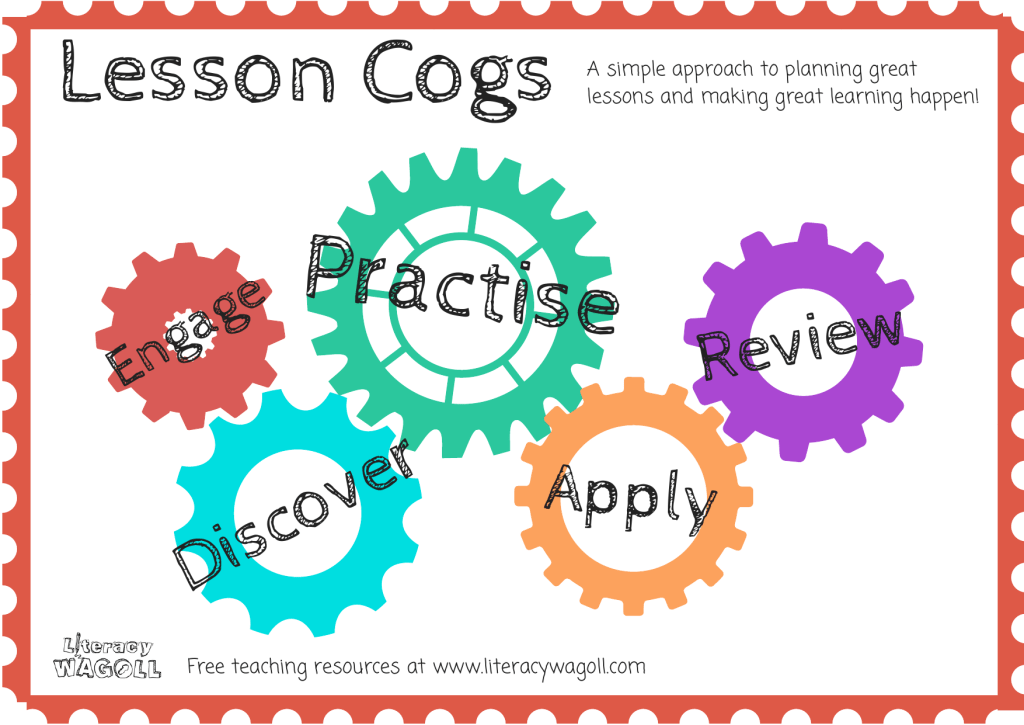
Cog 1: engage
Having children who aren’t engaged makes teaching tougher. Kids need to be onboard with your lesson in order to learn well.
These type of lesson activities excite and motivate children and give them a reason to learn. They make learning purposeful and enjoyable.
Children should be asked to do something fun, practical or exciting that wakes up the brain and gives a context to what they are learning. These should be short and snappy – around five minutes.
Cog 2: Discover
This is the beginning of new learning – the eureka moment, if you like. These activities involve children learning something new or building on an old idea.
It’s difficult to put a time scale on this cog as it all depends on the content and challenge of the new learning, but I usually find five to 15 minutes is a good length of time.
This lesson phase may be teacher-led, research-based or focused on identifying a misconception. Whatever your preferred teaching style, there’s a common goal – discovery.
Cog 3: Practise
No one ever learnt to drive by just being shown where the pedals are. Likewise, the next step in a child’s learning is practising what they have just learnt – 15 to 20 minutes should do the trick.
This gives children time to make mistakes. Paired, group and practical tasks work well here. Kids are great at helping each other, especially when they are all ‘in it together’.
Practise makes perfect, as they say.
Cog 4: Apply
In this modern educational world of mastery and reasoning, children should have an opportunity to use their new learning, to give it purpose.
Pupils will now be ready to solve problems and apply their new skills to real-life situations. Give children plenty of time to do this – I’d say 20 to 25 minutes.
Cog 5: Review
Sometimes called a plenary or even (shudder) a mini plenary, these activities are simply about reflection. They give children a chance to review what they have achieved so far, what they are finding difficult and what they need to do next.
This helps children to develop an understanding of the progress they are making. Although reviewing is important, don’t spend more than five to ten minutes on these moments.
No one wants to spend more time reviewing than actually learning.
No time wasted
Lesson cogs ensure that you understand the purpose and focus of every activity so that no time is wasted and your whole lesson drives towards a common learning goal.
They are intended to be flexible. No single lesson structure works all the time. Personalisation is key.
Look at what you want to achieve with the children and structure accordingly. The more you think about it, the more confident you will become. Indeed, as you gain familiarity with the cogs, so will the children.
In a recent lesson, a child put his hand up and said to me, “Sir, I think it’s time I stopped practising now and start applying. It’s only 30 minutes until lunch!”
3 lesson structures to try
There is no ‘one size fits all’ lesson structure. The three-part lesson is long gone and we are now all expected to be flexible.
Trending
However, by connecting activity cogs in different ways, you can create lesson structures for different purposes.
Just like Blue Peter, here are three I made earlier.
The standard lesson
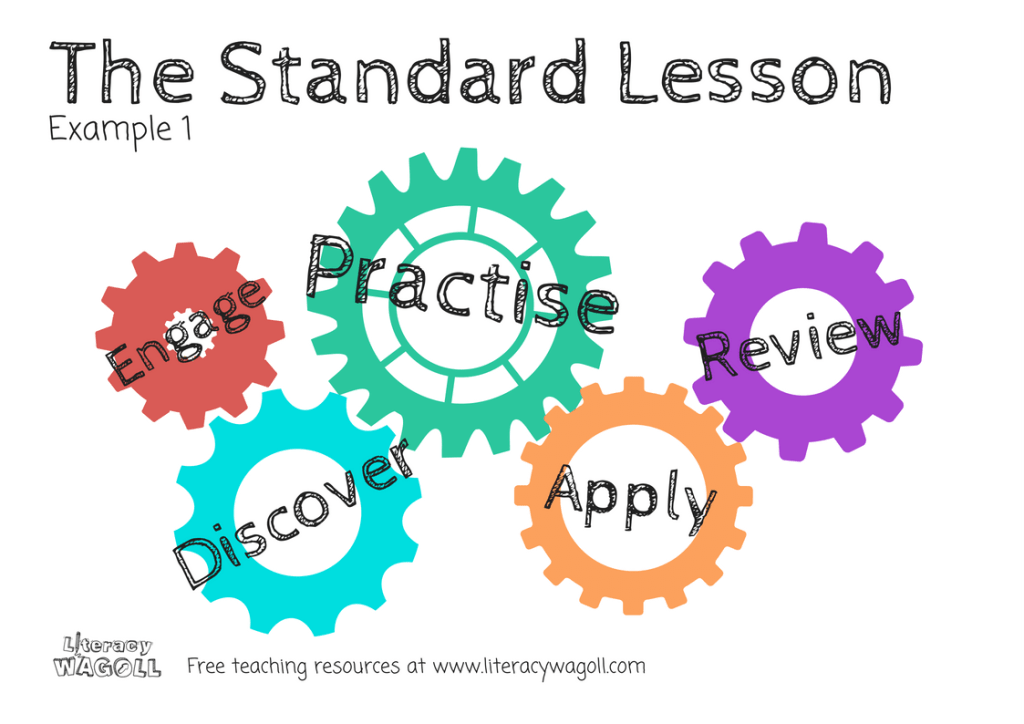
In an ‘everyday’ lesson (if there is such a thing), follow this simple sequence of activities. Engage pupils with a warm-up, then discover a new skill or build on a pre-existing one.
Follow this by rehearsing this new knowledge and applying it to a real-life situation. Finally, conduct a review where children evaluate their learning. Voilà – a standard lesson.
A new skill lesson
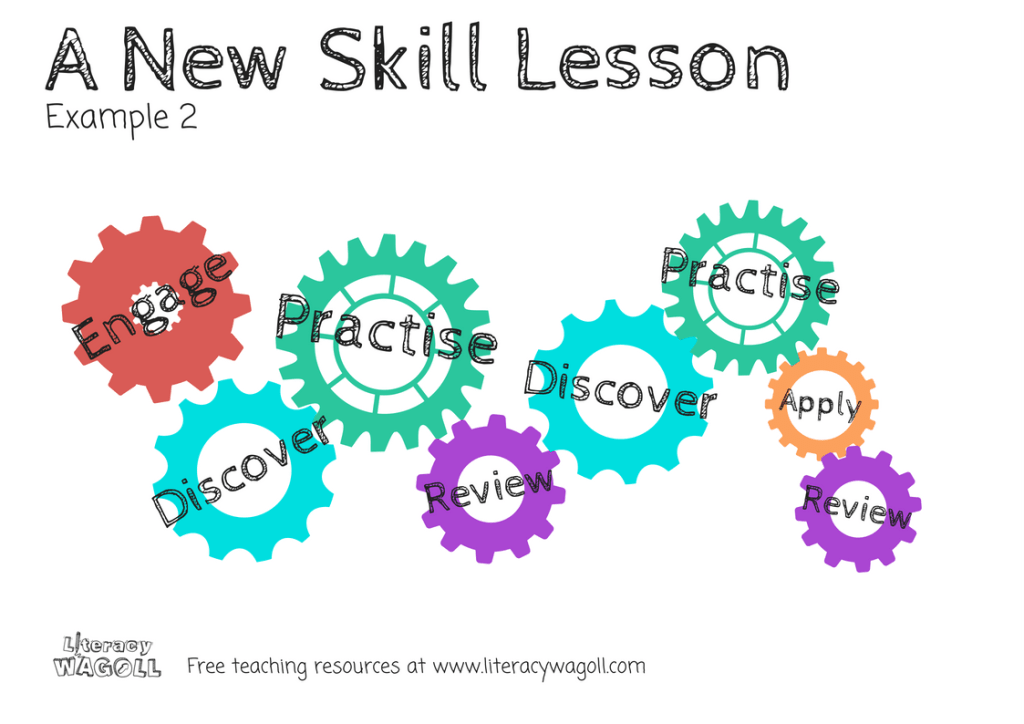
New skill lessons differ, as the emphasis is on the development of learning knowledge or skills for the very first time.
This lesson needs to focus on rehearsal and practising skills in different ways, with less application. Start with discovery, immediately followed by engagement and practice.
However, let’s face it, rarely do all children get it the first time, so add a splash of extra discovery and practice time for those who need it and a small dash of application for high flyers.
Insert regular, short review activities to allow children to check in on how far they’ve come.
A mastery lesson
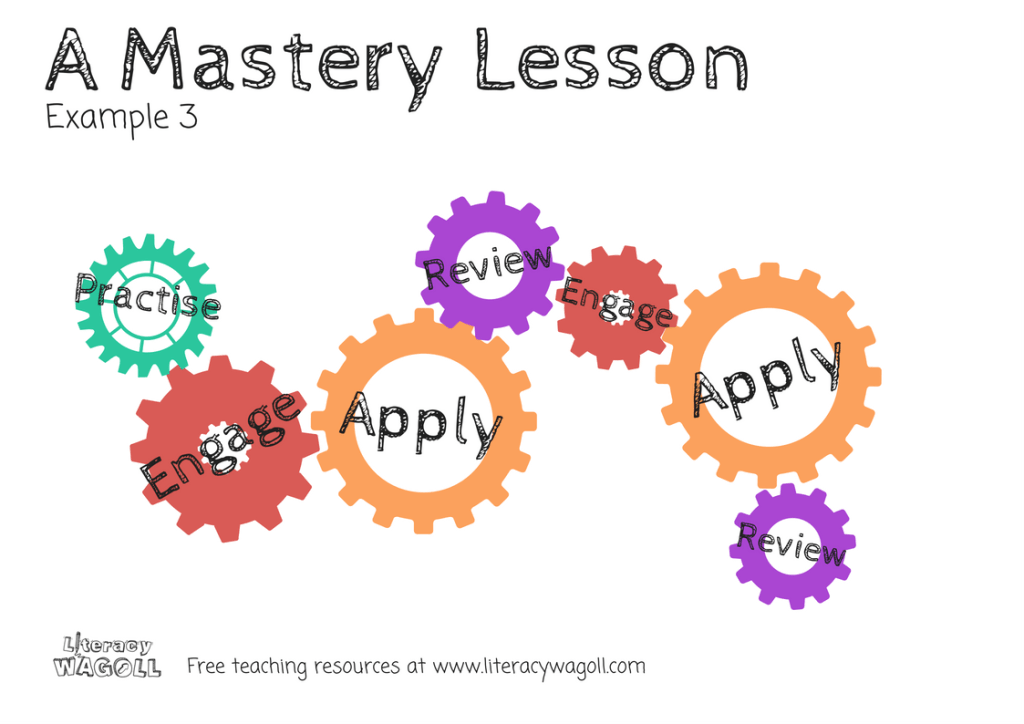
In contrast, mastery lessons build on skills that children have already acquired and help them deepen their knowledge of these. Practice activities are a little more redundant here – the focus is much more on application.
Plan two or three different opportunities to deepen pupils’ knowledge via multiple application activities. Combine this with short engagement activities to give context and add excitement to the problem-solving process.
Why you should stop planning lessons

Enough. Put down the pens and close the laptop. Because there is another way, urges Colin Foster…
I have a radical proposal – stop planning lessons. I don’t mean abandon planning altogether. Instead, stop planning individual lessons as self-contained units of learning.
Instead, I suggest planning a long ribbon of activities designed to support students in learning whatever it is that you want to teach them, without worrying about where the lesson breaks will come.
Doing this will actually make planning much easier, by removing a hard constraint that everything must fit into lesson-sized units.
The result will be appropriate activities that take as long as you judge, rather than as long as ‘there is’.
Wasted time
In the conventional way of planning lessons, lesson time is frequently wasted when you have, say, a five-minute activity to do at the end of the lesson, but there’s still another five minutes to go before it’s time to start said activity.
The students are left either doing a prior activity for longer than you’d ideally wish, or you choose another activity less because it’s pedagogically appropriate, and more because it will fill the gap.
Trying to package learning into lesson-sized chunks is also extremely wasteful of your planning time. You’ll hunt for activities that last for a specific length of time, but only find activities that are too long or too short.
“Trying to package learning into lesson-sized chunks is also extremely wasteful of your planning time”
Eventually you make a compromise and find something, but then once the lesson is in progress, the other activities leading up to that one turn out to take longer than expected.
That ten-minute gap contracts to five minutes, or disappears altogether, so the activity can’t be used anyway. And if you’ve planned the subsequent lessons as individual units you’ll have to be redesign them.
Again, this is a very poor use of your precious planning time.
A messy process
Instead, let’s embrace the fact that learning is inevitably a messy process that’s hard to predict, even for an experienced teacher working with students they know very well.
Unanticipated things come up. Students fly through things you expected them to find hard going, then come unstuck over what you thought was a trivial point.
We need the flexibility to respond to whatever happens and slow down or speed up as appropriate, and tightly-planned individual lessons don’t allow for this.
There’s no point in ‘doing formative assessment’ if, having identified a student difficulty, your lesson planning effectively prevents you from addressing it.
Trying to make a lesson into a neat and tidy set piece, with a beginning, middle and end (or starter, main and plenary) might look good on paper. It conveys a well-organised impression to any observers seeing only that one lesson.
But it doesn’t suit the realities of real learning.
This approach gives too much weight to the individual lesson, as against the broader sweep of students’ learning over a longer sequence of lessons.
Instead, the lesson should simply end when it ends.
Ending lessons
Whatever you’re doing, one minute before the bell’s about to go, just stop and pack away.
There’s no point in rushing something to finish it before the bell. If you could have completed it faster, you would have.
Rushing through it just means that the students won’t grasp the ideas, get confused and feel anxious. Chances are you’ll have to do it all again anyway.
This means that there’s never a bad time for the lesson to end.
For instance, suppose that you’ve just explained a new concept, but the students haven’t had any time to apply it – and then the bell goes. This is fine.
You can begin the next lesson with some retrieval practice: ‘What was the idea I introduced at the end of last lesson?’ Now we can do something with it.
“There’s never a bad time for the lesson to end”
Or suppose that students are half way through a discussion and no resolution has yet been reached – and then the bell goes. This is also fine.
The students can be invited to think about the issue more before the next lesson and come ready with their thoughts.
Then, at the start of the next lesson, you can take comments before you recap and continue.
- Stop planning for individual lessons
- Plan a continuous ribbon of activities that address exactly what you want your students to learn
- Sequence your ribbon of activities in the best way for learning
- Don’t worry about where the lesson breaks will come
- Monitor your progress against your curriculum every week and adjust your speed as necessary
Desirable difficulty
There’s plenty of evidence from cognitive science about the benefits of retrieval practice – especially after a time interval (spacing) and other things have intervened (interleaving) – so there are powerful advantages to breaking up learning in this way.
It might make the learning process harder and feel less smooth, but it produces a ‘desirable difficulty’ that tends to lead to better learning outcomes in the long term.
Lesson boundaries are artificial. Learning doesn’t take place in lesson-sized units. Planning a long ribbon of activities is more realistic.
“Learning doesn’t take place in lesson-size units”
Of course, you’ll want to put approximate timings alongside your ribbons of activities, but these are just a guide. They are to be checked in with on, say, a weekly basis, with a view to what needs to be completed by the next assessment point, such as half term.
In this way, it’s the suitability of each activity for the learning journey, rather than how long it’s expected to take, that’s uppermost in your planning, which is far better for students’ learning.
Lessons don’t have to be neatly rounded off at the start and end. Students don’t always have to walk out of the classroom with a sense of closure.
Walking out with some unresolved ideas and things to ponder further could be far more beneficial.
How to end lessons successfully

We often consider how to kick off lessons, yet pay less attention to bringing them to a conclusion, argue Daniel Sobel and Sara Alston, authors of The Inclusive Classroom: A New Approach to Differentiation…
Use pre-warnings
We all know how irritating it is when we are asked to stop something in the middle. Yet we do this all the time to children.
Instead of saying, “Pens down, finish what you are doing”, try giving children time warnings, so they know when they will be expected to finish a task.
By pre-warning pupils, we enable them to prepare for a smooth transition. There are many useful timers that can be displayed on interactive whiteboards to show the countdown to the end of any activity.
Have clear task endings
We often tell children to “finish their work”. This instruction carries with it the implication that the child knows what this means.
For most tasks, the expected finished result is flexible. Writing for 20 minutes will look different for different children. Most pupils can manage this degree of uncertainty, but not all.
The majority of children will benefit from understanding your expectation of the finished activity. This can be a modelled example or clear instruction, such as: “Complete ten sums” or “Write to here”, shown by a mark on the page, and so on.
Finished means finished
Setting a clear end to a task can be more complex than it first appears. When we set out a clear expectation for an activity, but a child finishes before the end of the lesson, it’s all too tempting to add an extension task.
Often this is the right thing to do. But for those children who are highly routine- or rule-bound, this creates confusion. For others, it tells them that if they complete their work they will just get more, so it is better not to complete it.
To counter this, be clear what your expectations are, or the unexpected presentation of an extension task can feel like a punishment and become a disincentive to complete the first one.
Plan end-of-lesson routines
Exactly what your finishing routine will be depends on the lesson and the age of your children, but what is clear is that it needs attention.
Think about including support for:
- ensuring children have their belongings and are organised enough to be able to pack them away
- helping children manage anxiety and sensory overload
- a clear and planned route to help children reach their next destination safely and within the time limit
Mark the stages of the lesson
Reception, and sometimes infant school classes, often use ‘tidy up music’, at the end of lessons to gently remind children to finish what they are doing and encourage them to tidy up.
It provides a clear auditory cue and support for transition. Many children need this kind of support long after we stop using it.
Consider age-appropriate ways of using visual and auditory signs to mark the stages of the lesson, so not only is the lesson end clear, but the journey through the lesson is clear as well.
Consider the use of a marker on lesson slides to display ‘Starting activities’, ‘Teacher input’, ‘Group activities’, ‘Individual learning’ and ‘Summing up’, for example.
Be aware of particular anxiety points
For some children, particular times of day or week may be triggers for increased anxiety.
Many children (and adults!) begin to struggle as they move towards lunchtime. For many, as they become hungry, particularly if this is combined with anxieties such as managing lunch routines, having sufficient time to eat or bullying from others, their ability to manage the end of the lesson successfully will be reduced.
At the end of the day there can also be anxieties about being picked up or managing the transition into an after-school activity.
Be cognisant of these anxieties and enable children to share them so you can support them to manage and hopefully reduce their anxieties.
Why originality is overrated when it comes to lesson planning

Colin Foster argues that planning a lesson from scratch should only ever be an infrequent last resort…
Imagine sitting at the back of a classroom, watching a lesson being taught by one of your colleagues. It’s a great lesson, no doubt about it. To be honest, you’re hugely impressed.
Afterwards, you’re full of praise and ask them, “Did you come up with that lesson yourself?” And they say, “No, I downloaded it off the internet.”
How would you feel? A little disappointed? You’d hoped the lesson was your colleague’s original creation, and now you’ve discovered that it wasn’t, it seems to take something away from what they did.
Quality matters, originality doesn’t
I think it’s a big mistake to feel this way. Originality is overrated. Pressure to plan lessons from scratch burdens teachers with an impossible amount of preparation that burns through what should be their downtime.
It’s far more important for students to have quality classroom learning experiences, than it is for their teacher to be the sole and original author of everything that’s used in the process.
“Pressure to plan lessons from scratch burdens teachers with an impossible amount of preparation”
Samuel Johnson is purported to have once told an aspiring author that “Your book is both good and original. Unfortunately, the parts that are original are not good, and the parts that are good are not original.”
Do we really want teachers to sit up late at night planning ‘original’ lessons that might be less good than something they could find on the internet?
Surely, it’s far better to spend that precious planning time adapting, improving or thinking through the details of something that someone else has already developed.
Trying to come up with content that’s original, simply for the sake of being original, is working to the wrong goal. After all, everything seems novel to students who are meeting it for the first time.
Tailoring lessons
But if you take your lesson plans ‘off the peg’ in this way, are you really being a true professional? Isn’t it selling your students short?
And in any case, won’t these ‘lifted’ resources clash with your teaching style and fail to meet your students’ particuar needs?
I’ve heard teachers sometimes assert that they have to develop their own lessons, because “Following someone else’s lesson plan is like trying to wear someone else’s clothes!”
Let’s unpack that simile. I wouldn’t have the first idea how to make my own clothes. But if you could, and opted to make all your clothes yourself, would they always be more comfortable to wear than the garments you could buy from a shop?
That seems a touch unlikely.
The process of trying to ‘tailor’ lessons for our perceived needs as teachers, and the needs we identify among our students, can often be conflated with the ‘learning styles’ fallacy – the idea that everyone learns differently, and that we should try to make our lessons conform to every individual child’s preferences.
However, the research is clear that designing lessons to fit preferred learning styles doesn’t improve learning.
Conversely, the notion that teachers should plan their own lessons has long been seen as a marker of professionalism. This can almost border on the moralistic, with the implication that you’re somehow doing something wrong if you succeed with a lesson you didn’t put the hard graft into planning yourself.
Double standards
Yet this doesn’t seem to apply in the same way for other professionals. Do the best doctors make their own medicines? Of course not, and the ones that do are typically considered to be ‘quacks’!
Real doctors rely on medicines manufactured and tested by the pharmaceutical industry, but that fact doesn’t mean that doctors are reduced in our eyes to technicians, merely ‘handing out pills’.
By the same token, teachers who base their lessons on resources and plans produced by fellow professionals are doing nothing wrong.
“There is no point in reinventing the wheel every time”
Perhaps medicine is a poor comparison, given that the processes of teaching tend to be seen as more personal than the dispensing of medicine. But when we consider professionals working in other fields, we find much the same thing.
Do the best actors write their own scripts? True, some actors are indeed also writers, but it would be a big mistake to think that when Judi Dench performs Shakespeare, she’s being less creative and less professional than she would be if she only performed her own material.
An actor in possession of a great text is likely to have much more scope to express their creativity than they might with a weaker script that they wrote for themselves.
Autonomy and creativity
Of course, teachers aren’t actors or doctors, but I’d suggest that a teacher’s role is thought about and understood in a way that overstates the individualised aspects of what they do.
Possessing a degree of professional autonomy doesn’t have to mean doing everything by yourself. Being creative needn’t involve building all the resources and materials you use from scratch each time, without any help.
As fellow professionals, we can and do support one another. There may even be a case to be made for incorporating some level of professional specialisation into the role.
Perhaps there are individuals out there who are really good at writing lesson plans, but less good at implementing them, and vice versa? (Just as there are outstanding playwrights who can’t act for tuppence.)
Someone else might be much stronger at interpreting, adapting and implementing existing lesson ideas than coming up with their own – and that should be fine too.
The teacher who uses a well-selected, high-quality lesson plan produced by someone else shouldn’t be treated as lazy, less skilled or any less professional in their approach to the role.
We must prevent an impoverished understanding of autonomy from taking hold – the kind of attitude that calls on teachers to plan all their lessons, by themselves, from scratch.
If it ain’t broke
Self-creation is just one route to ownership of something. A new jacket becomes our own over time as we wear it and become familiar with it, even though we almost certainly didn’t make it ourselves.
In the same way, there’s nothing inherently de-professionalising about finding, or being given a lesson plan to ‘deliver’.
Where necessary, you’ll take time to ‘make it your own’ and adapt it as needed – but if it ain’t ‘broke’, there’s no need to ‘fix it’.
Let’s therefore agree to respect the skills and efforts of our fellow professionals, and push back against the idea that teachers have to constantly undo and redo their work simply for the sake of it ‘being theirs’.
Give credit where it’s due, and borrow freely from the best you can find.










